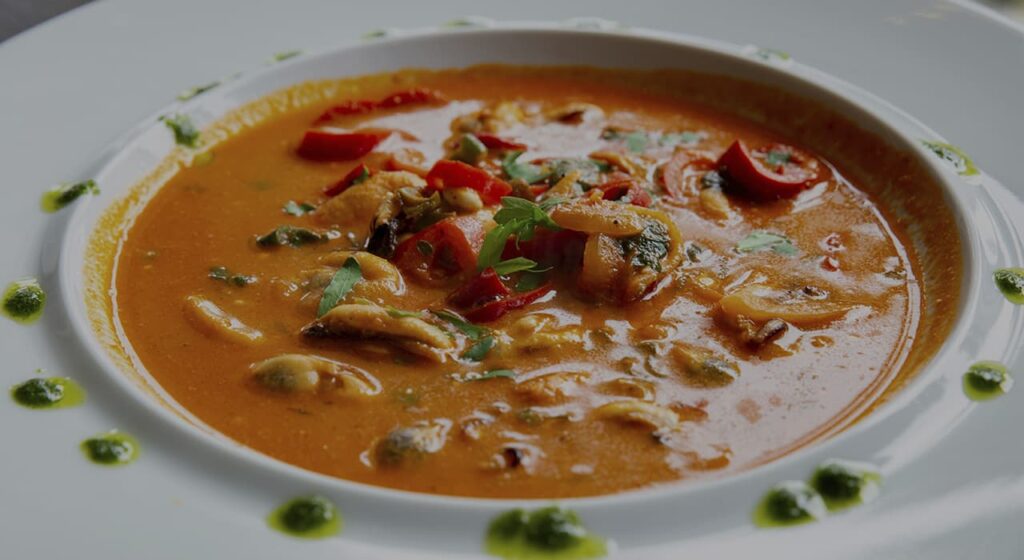You want to please your family with tasty and healthy soups every day, but…
Soups don’t taste good or look the same?
Learned to cook 3-5 types of soup and not enough variety?
You are afraid to cook national dishes according to recipes from the Internet, because you don’t know what the result will be of local products and whether it will be worth the effort?
Chef has worked out for you authentic soups and adapted them to local products and home technology to make them easy and delicious at home.
Diversify your menu with bright and delicious soups from around the world under the supervision of a chef.
Most Popular Soups In The World
- Gazpacho (Spain): Originating from Andalusia, Gazpacho is a cold soup made with fresh ingredients like tomatoes, garlic, onions, pepper, and olive oil. It has evolved from a medieval peasant dish, gaining tomatoes from the New World in the 16th century;
- Harira (Morocco): A fragrant soup made with lamb, chickpeas, and tomatoes, traditionally consumed during Ramadan. Seasoned with spices like saffron, cinnamon, ginger, and nutmeg, Harira offers a smooth texture and a rich flavor profile;
- Laksa (Malaysia and Singapore): A spicy curry and coconut milk-based broth, complemented with ingredients like shrimp, chicken, or tofu. Laksa is a fusion of Chinese and Southeast Asian culinary traditions;
- Yayla çorbası (Turkey): A yogurt-based soup with rice and chickpeas, flavored with spices and herbs. Originating from the Assyrian people, it’s known for its nutritional value and is often served in Turkish hospitals;
- Minestrone (Italy): A vegetable soup that emerged during the First World War, made with whatever vegetables were available. It symbolizes the adaptability and resourcefulness of Italian cuisine;
- Tom Yum (Thailand): Known for its aromatic and spicy broth, made with lemongrass, galangal, and kaffir lime leaves. Tom Yum can feature various proteins, like shrimp, chicken, or pork.
- Tortilla Soup (Mexico): A tomato broth soup with fried corn tortillas, seasoned with onion, garlic, parsley, and pepper. It combines pre-Columbian and Spanish culinary traditions;
- Caldo Verde (Portugal): Made with collard greens, potatoes, and chorizo, this soup is a staple of Portuguese cuisine, particularly from the Minho region;
- Phở (Vietnam): A soup with rice noodles and beef in a spiced broth, Phở is a Vietnamese staple that reflects the country’s rich flavors and textures;
- Soupe à l’Oignon Gratinée (France): An onion soup that evolved from peasant food to a refined dish, characterized by caramelized onions in a seasoned broth, topped with bread and melted cheese;
- Wonton Soup (China): A light and aromatic broth with wontons (dough filled with meat or vegetables), reflecting the rich soup tradition of China;
- Chupe de Marisco (Peru): A creamy seafood soup from Peru, made with a seasoned cream, cheese, and white wine;
- Soto (Indonesia): A meat and rice noodle broth with variations like Soto Ayam, showcasing Indonesia’s diverse culinary influences;
- Chowder Soup (USA): A creamy seafood soup with European origins, adapted by various regions in the USA with ingredients like onions, potatoes, and bacon;
- Tacacá (Brazil): Originating from the Amazon region, this soup is made with tucupi, jambu, dried shrimp, and tapioca, representing Brazil’s indigenous culinary heritage;
- Goulash (Hungary): A hearty soup with meat, paprika, and sometimes potatoes or pasta, reflecting Hungarian shepherds’ culinary practices;
- Tinola (Philippines): A broth with chicken, ginger, and local vegetables, Tinola is a versatile and beloved Filipino soup;
- Efo Elegusi / Egusi (Nigeria): Made with melon seeds, palm oil, and various proteins, Egusi soup is a staple of Nigerian cuisine;
- Ramen (Japan): A broth with noodles and various side ingredients, Ramen is a symbol of Japanese culinary diversity with Chinese origins;
- Borscht (Russia / Ukraine): A beet-based soup that can be served hot or cold, Borscht is a staple of Eastern European cuisine, with both Russia and Ukraine claiming its origins.
Training format
Learn from chefs
The teachers at the school are professionals with years of experience. You will do your homework on the school’s platform and get an in-depth review from our expert chefs. Ask questions to the tutors on the platform or in the Telegram-chat.
Study when it’s convenient.
All lessons are already recorded, watch and prepare whenever it’s convenient. There are mandatory “stop lessons” within the courses, completing which gives you access to a large number of open lessons at once.
Cook with the products available
You’ll buy most of the groceries on your way home. But if you can’t find or eat something, the course has worked out substitutions, and there are curated chefs in the chat room with whom you can discuss adapting the recipe to suit you.
After the course, you:
Know how to make 6 of the world’s most popular types of soups
Have amassed your own base of tried and true favorite soups
Understand what can be removed or substituted without losing flavor
Scope:
- 9 lessons of theory and practic;
- 6 video-practices.
